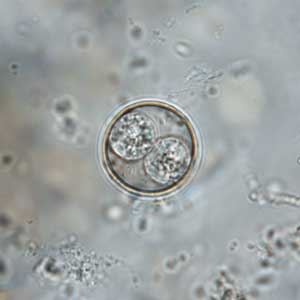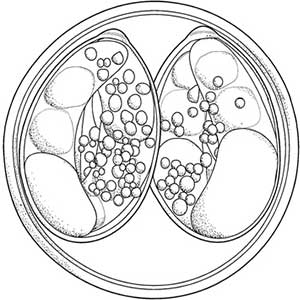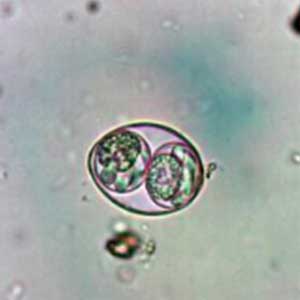Isospora is a coccidia from the Eimeriidae family which can be found in a large number of species (domestic carnivores, production animals and birds). They are normally host-specific. Seven species have been reported in non-human primates: Isospora callimico, I. endocallimici, I. scorzai, Isospora cebi, I. papillonis, I. saimiriae and I. arctopitheci (Strait et al., 2012). This last species is the most frequently encountered Isospora spp. in non-human primates.
Epidemiology
Coccidia are cosmopolitan parasites which can affect both Old and New World Monkeys, as well as great apes. Various species of non-human primates have been reported to be affected by Isospora (Lindsay et al. 1997; Duszynski et al. 1999 and Strait et al. 2012):
- Goeldi’s marmosets (Callimico goeldi) by Isospora callimico and endocallimici;
- Uakaris (Cacajo rubicundus) by Isospora scorzai and arctopitheci;
- Weeper capuchins (Cebus olivaceus) by Isospora scorzai and arctopitheci;
- White-fronted capuchins (Cebus albifrons) by Isospora cebi;
- Chacma baboons (Papio ursinus) by Isospora papillonis;
- Common squirrel monkeys (Saimiri sciureus) by Isospora saimiriae and arctopitheci;
- Senegal busbabies (Galago sengalensis), Geoffroy’s tamarins (Saguinus geoffroyi), Colombian White-faced capuchins (Cebus capucinus), black-headed spider monkeys (Ateles fusciceps), three-striped night monkeys (Aotus trivirgatus), mantled howlers (Alouatta palliata), black-tufted marmosets (Callithrix penicillate) by Isospora
Description
Isospora oocysts can be identified on coproscopy. They are round, stain with Lugol, are refringent and measure 15 to 50 µm in diameter (Duszynsky et al, 1999). They can be either sporulated or non-sporulated:
- If they are not sporulated, they have a granulomatous content and no identifiable structures inside (in this form, it is impossible to differentiate them from Eimeria eggs);
- If they are sporulated, they contain two sporocysts with four sporozoites each.
Like many other coccidia, they stain with modified Ziehl-Neelsen. Species cannot be differentiated with coproscopy alone (Strait et al., 2012).
Differential diagnosis
Differential diagnosis includes two other coccidia species: Cyclospora and Eimeria. However:
- Cyclospora oocysts are smaller (8 to 10 µm in diameter). Moreover, when sporulated, they contain two sporocysts with two sporozoites each (Colomina Rodríguez & Villar Serrano, 1997). Like Isospora, they affect both Old and New World Monkeys (Strait et al., 2012; Li et al., 2015).
- When sporulated, Eimeria oocysts contain four sporocysts with two sporozoites each and only affect Prosimians (Duszynsky, 1999).
Sporulation of oocysts by coproculture and/or the use of specific microscopic techniques (fluorescence microscopy or interferential contrast microscopy) can sometimes be necessary to differentiate coccidia species.
Clinical significance
Isospora infection is asymptomatic in most non-human primates. Nevertheless, a study has shown that Isospora arctopitheci could be pathogenic in Geoffroy’s tamarin (Saguinus geoffroyi), causing hemorrhagic diarrhea which could even lead to the death of the animal (Lindsay et al., 1997).
Prophylaxis and treatment
As Isospora spp. are for the most part non-pathogenic in non-human primates, treatment is not normally required. Nevertheless, the use of sulfadimethoxine (50 mg/kg once a day during 10-14 days), amprolium (100-400 mg/kg during 5 days or 110-220 mg/kg during 7-12 days), trimethoprim-sulfamethoxazole and toltrazuril (20-30 mg/kg once) have been described to treat Isospora infection (Lindsay et al., 1997). Moreover, hygienic measures need to be taken in case of diagnosis in a captive setting.




